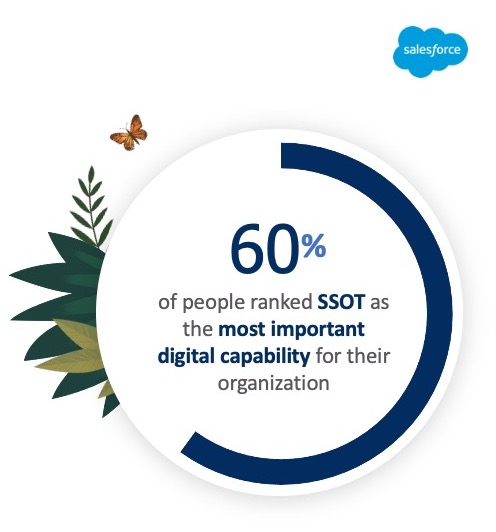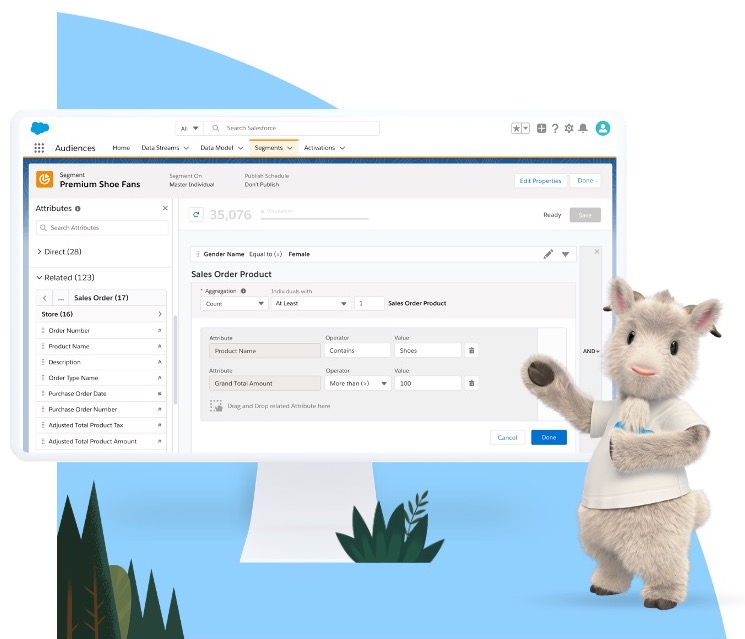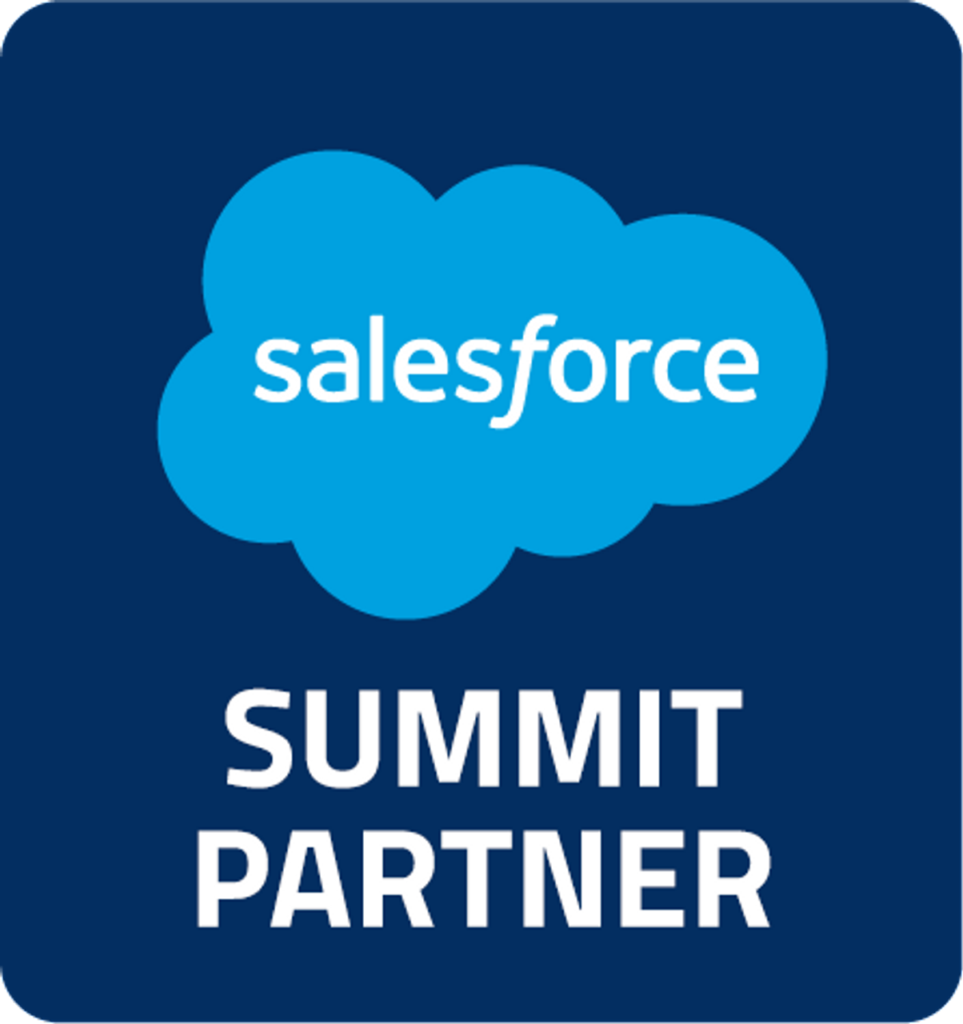How Marketers Can Achieve Consistent Data Exchange Across Salesforce
The hottest new piece of marketing technology is the Customer Data Platform (CDP), which collects data from various sources, unifies it, segments it, and activates it for effective customer engagement.
Formerly known as Customer Audience 360, Salesforce CDP serves as a unified customer profile, providing a single source of truth (SSOT) to personalize experiences across marketing, commerce, service, and sales, ensuring consistent customer data exchange across the Salesforce ecosystem by integrating data from different sources to improve understanding of customer behavior.

According to Salesforce’s “The Future of Digital Customer Research” (2020), 60% of people ranked SSOT as the most important digital capability for their organization. To succeed in a digital-first approach, brands must create digital experiences that feel as personal as human relationships.
As customer preferences evolve, the data that represents them must also evolve. However, many brands struggle with static data and fail to unify it into a customer database that includes marketing , commerce, service, and sales.

The main barrier to personalization across channels is data sitting in different silos.
Additionally, customers have multiple IDs, move between channels in real time, and face constantly changing privacy legislation and data collection rules. The main challenge for marketer is unifying data and managing smooth execution.
What is a Customer Data Platform and what does it do?
By combining various data from different silos, a CDP provides a holistic view of a customers’ journey. Let’s explain this with an analogy.
A CDP is like a marketer’s brain, replicating human-to-human relationships. Marketers and businesses need a technological equivalent of the human brain. An integrated system that collects, unifies, and interprets information. It helps us to improve the relationships that we have with the people around us. This is exactly what a CDP does. A CDP simplifies and connects all the information businesses gather over time about their consumers. It uses willingly provided information to develop more effective and convenient relationships. This platform must offer a single source of truth for every person a business interacts with. This system needs to act as the business’s brain.
This integrated system allows businesses to manage identity resolution effectively, ensuring every interaction is contextual and personalized.

What is a CDP vs CRM
A common question arises: What is the difference between a CDP and a CRM? While both customer relationship management (CRM) systems and CDPs manage customer data, CRMs focus on customer interactions and sales processes, while CDPs are designed specifically for marketing. It gathers and organizes data from multiple sources, providing insights for targeted marketing campaigns, reporting, and analytics.
Don’t confuse it with the core CRM platform, which manages customer relationships, sales engagements, pipelines, interactions, and transactions, while a customer data platform gathers, organizes, and enriches data from multiple sources, focusing on marketing rather than sales or service. A customer data platform gathers, organizes, and enriches data from multiple sources, focusing on marketing rather than sales or service.
Another common question: Is CDP the same as a Data Management Platform (DMP)? While both platforms manage data, a DMP focuses on third-party data for advertising, whereas a CDP centralizes first-party data to create a unified customer profile and optimize customer experiences.

How does a CDP work?
Unify data from everywhere
The platform features deep integrations with Marketing Cloud, Sales & Service Cloud, Loyalty Cloud, Commerce Cloud, Interaction Studio, Tableau, Datorama, and Mulesoft. It allows data consumption in any application using high-scale queries across Salesforce.
Create a unified Customer Profile: connect & match customer data:
This capability helps marketers master known and unknown customer resolution and map data into a single information model. The system provisions a global party ID that maps multiple child identities to a main parent profile. Cross-device identity helps customers build their known-to-unknown identity graph. More features will be added in the future to improve this identity spine.

A good example of why we need an identified profile is Samantha, who has profiles and engagement data in multiple systems that provide her with customer experience. She has marketing engagement data reflecting the campaigns she participates in through her chosen contact points. She places orders in Commerce, both registered and guest checkouts. Her Community Profile shows her interactions with her online community. Contact records in Service reflect her requests for help. Some of this data may reside within Salesforce products, but some—like in-store point-of-sale data, legacy loyalty data, and data from Business Intelligence (BI) tools—does not. With all of Sam’s disconnected data, we need a common way to identify her throughout her digital experiences.
Create smart segments and activate anywhere
The segmentation engine is the heart of Salesforce CDP, enabling businesses to query all of the data in the system. Marketers can leverage attributes from sales, service, commerce, loyalty, Enterprise Resource Planning (ERP) and modeled data in an easy-to-use interface. Immediate population results help understand the composition of the granular segments of customers. Activation is as simple as clicking a button to send segment data for messaging, advertising, personalization, and analytics.

Activate data to any cloud and any application
Use built-in connectors to publish data to messaging, advertising, and personalization endpoints. Unleash your first-party data asset across commerce, sales, service, and over 8,000 trusted partners. It enables data ingestion and activation at scale not just for Salesforce endpoints, but also the broader ecosystem through Mulesoft and AppExchange pipes and connections.
Embed your data with intelligence – make it available to analytics
One of the most powerful features of CDP is a set of insights services that help customers apply calculated insights to their profiles through modeling. Insights leverage Einstein to make data smarter, delivering models and scoring that make every interaction more relevant. A native integration with Tableau enriches BI for deeper insights using the unified profile. Datorama integration supports marketing optimization with audience insights automated via an Application Programming Interface (API).

Why use a Customer Data Platform?
CDPs have gained popularity among data-driven enterprises due to fragmented data across different silos. Salesforce CDP users benefit from new integrations with Mulesoft, allowing them to ingest customer data from external sources like loyalty platforms and ERP systems. This capability optimizes data management and allows marketers to create effective audience segments for campaigns. In conclusion, Salesforce CDP is not just a tool for marketers; it is an essential part of a modern business strategy. By leveraging behavioral data and insights, businesses can adapt to the cookieless future, ensuring compliance with privacy laws while delivering personalized experiences across all channels.



